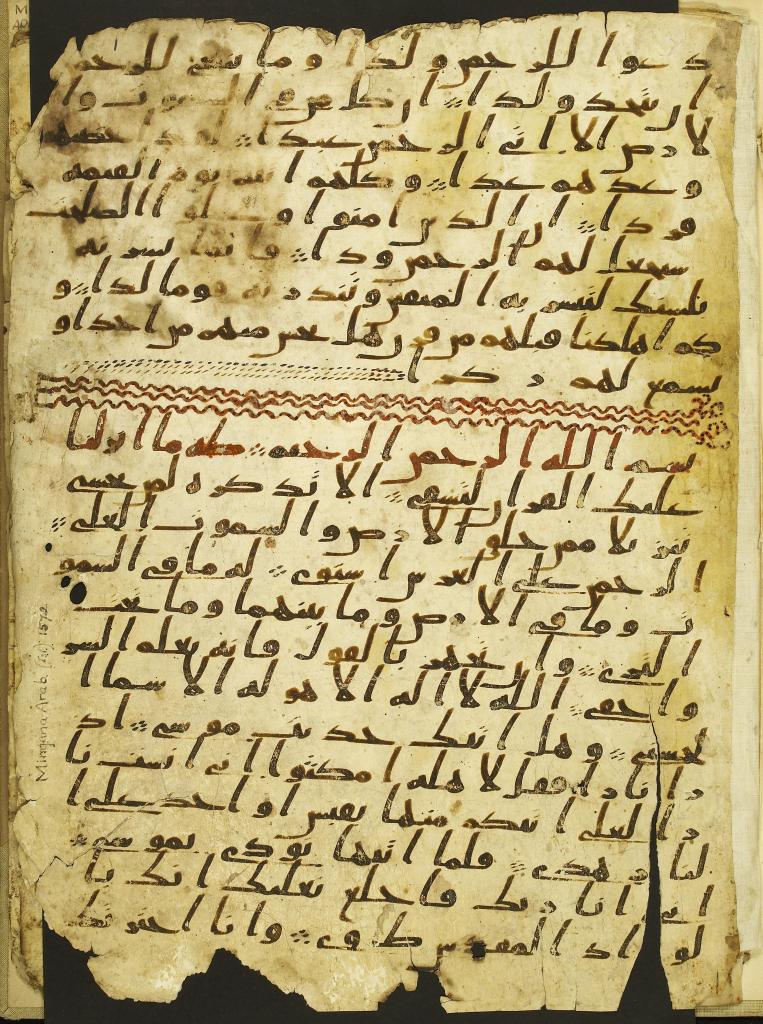‘Oldest’ Qur’an fragments found in Birmingham University
According to a just published BBC News article, a recent re-dating of manuscripts of the Mingana collection at the University of Birmingham (UK), has led to another re-dating that places the manuscripts to between 568 CE and 645 CE with a 95% probability:
Radiocarbon dating found the manuscript to be at least 1,370 years old, making it among the earliest in existence.
The tests, carried out by the Oxford University Radiocarbon Accelerator Unit, showed that the fragments, written on sheep or goat skin, were among the very oldest surviving texts of the Koran.
These tests provide a range of dates, showing that, with a probability of more than 95%, the parchment was from between 568 and 645.“They could well take us back to within a few years of the actual founding of Islam,” said David Thomas, the university’s professor of Christianity and Islam.
“According to Muslim tradition, the Prophet Muhammad received the revelations that form the Koran, the scripture of Islam, between the years 610 and 632, the year of his death.”
Prof Thomas says the dating of the Birmingham folios would mean it was quite possible that the person who had written them would have been alive at the time of the Prophet Muhammad.
“The person who actually wrote it could well have known the Prophet Muhammad. He would have seen him probably, he would maybe have heard him preach. He may have known him personally – and that really is quite a thought to conjure with,” he says.
The collection consists of 9 folios, they are written in Hijazi script and have been carbon and palaeographically dated.
The collection has been split in two collections, now known as Mingana Arabic 1572a and Mingana Arabic 1572b. The collection that this article is about, is Mingana Arabic 1572a. The University has just updated the collection’s codifiction (classification). The “oldest” manuscripts, are 2 leaves (folios, pages) of the original 9 leaf (folio, page) collection. They have been both carbon and palaeographically dated.
The collection was re-dated several months ago to 1st century Hijri, and this is the second re-dating within a year, confirming it’s early dating.
More Information:
- Mingana Collection (1572) before today’s latest re-dating can be found on Islamic Awareness.
Birmingham University’s scans of the Mingana Collection (1572), without updated information on re-dating, can be found here.- Birmingham University has updated the codification/ classification of the collection. The collection we are concerned with is now known as Mingana Arabic 1572a, which can be found here, and the other 7 leaves/ pages/ folios of the original 9 leaf/ page/ folio collection is now known as Mingana Arabic 1572b and can be found here.
I’d like to thank Br. Kaleef from Discover the Truth for bringing the BBC article to my attention, may Allah reward him accordingly, Ameen.
Article in Arabic (Br. Ahmed Shaker):
من جديد أخبار المخطوطات القرآنية المبكرة:
أوراق قرآنية مكتوبة بالخط الحجازي من مجموعة ألفونس منجانا بجامعة برمنجهام تم إخضاعها لفحص الكربوني المشع (C14) في أحد معامل جامعة أوكسفورد فكانت النتيجة أنه من المرجح بنسبة 95% أن تكون هذه الأوراق قد نشأت في الفترة ما بين 568م و645م = 56 قبل الهجرة إلى 24 هجرية.
تعليقات (ديفيد توماس) أستاذ المسيحية والإسلام في جامعة برمنجهام:
هذه الأجزاء من القران التي كتبت على هذه الرقائق، يمكن، وبدرجة من الثقة، إعادة تاريخها إلى أقل من عقدين بعد وفاة النبي محمد. إن الشخص الذي كتب هذه الصفحات لابد أنه عرف النبي محمد، وربما رآه واستمع إلى حديثه، وربما كان مقربا منه، وهذا ما يستحضره هذا المخطوط.
إن هذه الصفحات قريبة جدا من القرآن الذي نقرأه اليوم، وهو ما يدعم فكرة أن القرآن لم يعرف إلا تغييرا طفيفا، أو أنه لم يطرأ عليه أي تغيير، ويمكن اعادة تاريخها الى لحظة زمنية قريبة جدا من الزمن الذي يعتقد بنزوله فيه.
and Allah knows best.


You must be logged in to post a comment.